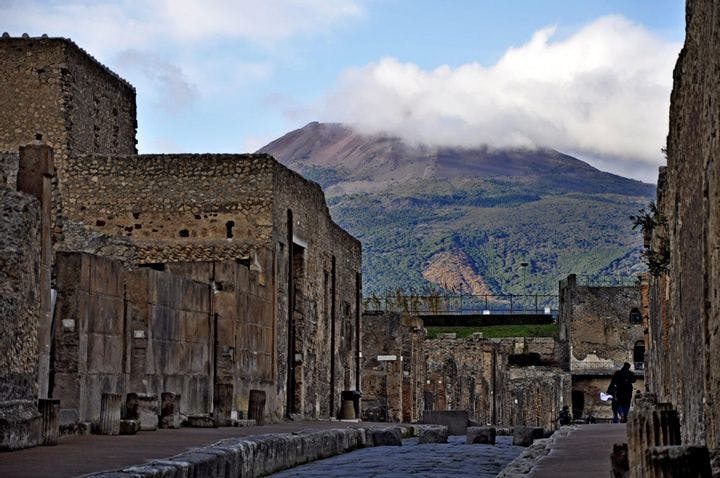Spring 2009
Preserved in Time
– Andrew Curry
Andrew Curry on Pompeii.
On a summer day 1,930 years ago, Italy’s Mount Vesuvius erupted, overwhelming the town of Pompeii and its inhabitants within minutes in a flood of superheated gas and volcanic ash. Since the 1700s, when the town’s excavation began, generations of archaeologists and historians have regarded the site as an invaluable snapshot of life in a typical Roman city: Pompeii, in the popular imagination, is a city “frozen in time.”
But is it really? The truth, as University of Cambridge classics professor Mary Beard emphasizes in The Fires of Vesuvius, is quite different. Pompeii, near modern-day Naples, was apparently a midsize port and popular vacation destination for wealthy Romans. Yet far from a snapshot of daily Roman life, what archaeologists unearthed was a town under extreme duress. The numbers tell the tale: Only 1,100 bodies have been found in the ruins, while estimates for the town’s population range from 6,400 up to 30,000. In Pompeii’s final hours, its populace fled, carrying their valuables. The ghoulish plaster casts of the dead for which the site is famous capture not unsuspecting townspeople, but the final moments of an unlucky few who waited too long to clear out. And some of the ruins we see today may have been ruins back then too: At the time of the eruption, Pompeii was still rebuilding after a severe earthquake that had devastated the area 17 years earlier.
In a survey that encompasses Pompeians’ religion, diet, and even traffic patterns, Beard sets out to correct many of the misimpressions that countless guidebooks—and guides—have foisted on tourists. The town’s ruins became a mandatory stop on the Grand Tour of 18th- and 19th-century Europeans. Visitors were captivated by the idea of witnessing a moment in time—and by the twisted forms of ancient Romans. Writers from Percy Bysshe Shelley to Edward Bulwer-Lytton penned Pompeii-inspired reflections on the fragility of life and love. The town’s residences were given romantic names such as the House of the Tragic Poet, the House of the Golden Bracelet, and the House of the Prince of Naples by excavators, visitors, and sponsors. More than two centuries of tourism and excavation have left a legacy of assumptions that cloud our understanding of the site—and, since Pompeii contains some of the best evidence about daily life in the Roman world, about Rome itself.
The Fires of Vesuvius lays out decades of specialist debate in clear, reader-friendly prose. To present the scholarship as smoothly as possible, Beard has gathered her sources in an appendix, often alluding to them in the main text with frustratingly vague phrases such as “some historians have suspected” and “fascinating details continue to be discovered.” But the various scholarly debates she describes are themselves fascinating, even if she stops short of providing many new interpretations or conclusions of her own.
Take the Pompeian Brothel Problem, a debate among scholars as to which of the hundreds of buildings in town can plausibly be called houses of ill repute. The estimates range from a lusty 35 bordellos to just one, a somewhat depressing five-cell affair whose erotic murals and more than 150 (unprintable) graffiti make it one of the most popular sights in town today. Or what about the proliferation of penises, which pop up everywhere you look—over bread ovens, carved into paving stones, painted on frescoes, and scrawled on walls. “Phallus birds” adorned with little bells even hung over the entrance to many of the town’s inns and bars. Were the Romans wildly oversexed—or was the phallus simply a symbol of good luck, a little like our four-leaf clover today? For all we think we know about Pompeii and the Romans, there are some questions that continue to tease.
* * *
Andrew Curry, a freelance writer living in Berlin, is a contributing editor to Archaeology.
Reviewed: The Fires of Vesuvius: Pompeii Lost and Found by Mary Beard, Harvard University Press, 304 pp, 2008.
Photo courtesy of Flickr/Carlo Mirante
Up next in this issue
